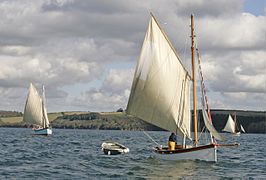Fishing dredge
A fishing dredge, also known as a scallop dredge or oyster dredge, is a kind of
Construction

The dredge is usually constructed from a heavy steel frame in the form of a scoop. The frame is covered with chain mesh which is open on the front, which is towed. The chain mesh functions as a net.
Dredges may or may not have teeth along the bottom bar of the frame. In Europe, early dredges had teeth, called tynes, at the bottom. These teeth raked or ploughed the sand and mud, digging up buried clams. This design was improved by using spring-loaded teeth that reduced bottom snagging, and so could be used over rough ground.
Dredge nets have a coarse mesh in order to let organisms smaller than the target species through. The net catches the larger organisms: in the case of scallop dredging that includes the scallops' predators, such as whelks, starfish and octopus.
In some cases, several dredges are attached to a wheeled rigid axle in groups of three or four. A number of these dredges can be towed from a heavy spreading bar, usually one from each side of the vessel. The length of the bar and number of dredges towed depends on the power of the vessel and the room on the side deck for working the dredges. The number might be three on each side of a small 10-metre (33 ft) boat up to 20 on each side for a 30-metre (98 ft) vessel with 1500 hp.[2] The great weight and strength of the gear can disturb the ground it is towed over, overturning rocks and dislodging and crushing organisms in its path.[1]
Like a better mouse trap, there is still a challenge for inventors to produce a kinder and more gentle scallop dredge.[3]
Types of dredgers
-
Mussel dredgers
-
benthic dredge, leaving the port of Nieuwpoort
-
Oyster boats of the Truro oyster fleet. This fishery is the last in the world to work by sail alone
Dredging history
-
Vessels dredging for oysters, c. 1875
-
Oyster dredge at work, c.1875
-
dredge and its winch from a skipjack
Dredging art
-
Oyster Boats North River, by John Henry Twachtman (1853–1902)
-
Oyster Sloop, Cos Cob, by Childe Hassam (c.1902)
-
Dredging For Oysters, by Alexander Rummler. WPA mural.
See also
- Bottom trawling – Fishing method for fishing trawlers
- Gathering scallops – Common name for several shellfish, many edible
- Gathering seafood by hand– Methods for catching sea creatures, especially fish
- Marine biology dredge
- Oyster dredging boats:
- Solway Harvester – A scallop dredger
Notes
- ^ ISBN 0-632-05608-8. Page 14
- ^ Dredges Archived 2009-03-26 at the Wayback Machine seafood.org. Retrieved 11 February 2009.
- ^ MIT (2007) Kinder, gentler scallop dredge invented. Retrieved April 13, 2008.
References
- National Research Council (US) (2002) Effects of Trawling and Dredging on Seafloor Habitat. Committee on Ecosystem Effects of Fishing. ISBN 0-309-08340-0
- Hall-Spencer & Moore PG (2000) Scallop dredging has profound, long-term impacts on maerl beds. ICES Journal of Marine Science. 57, 1407-1415.
This article includes a list of general references, but it lacks sufficient corresponding inline citations. (July 2011) |











